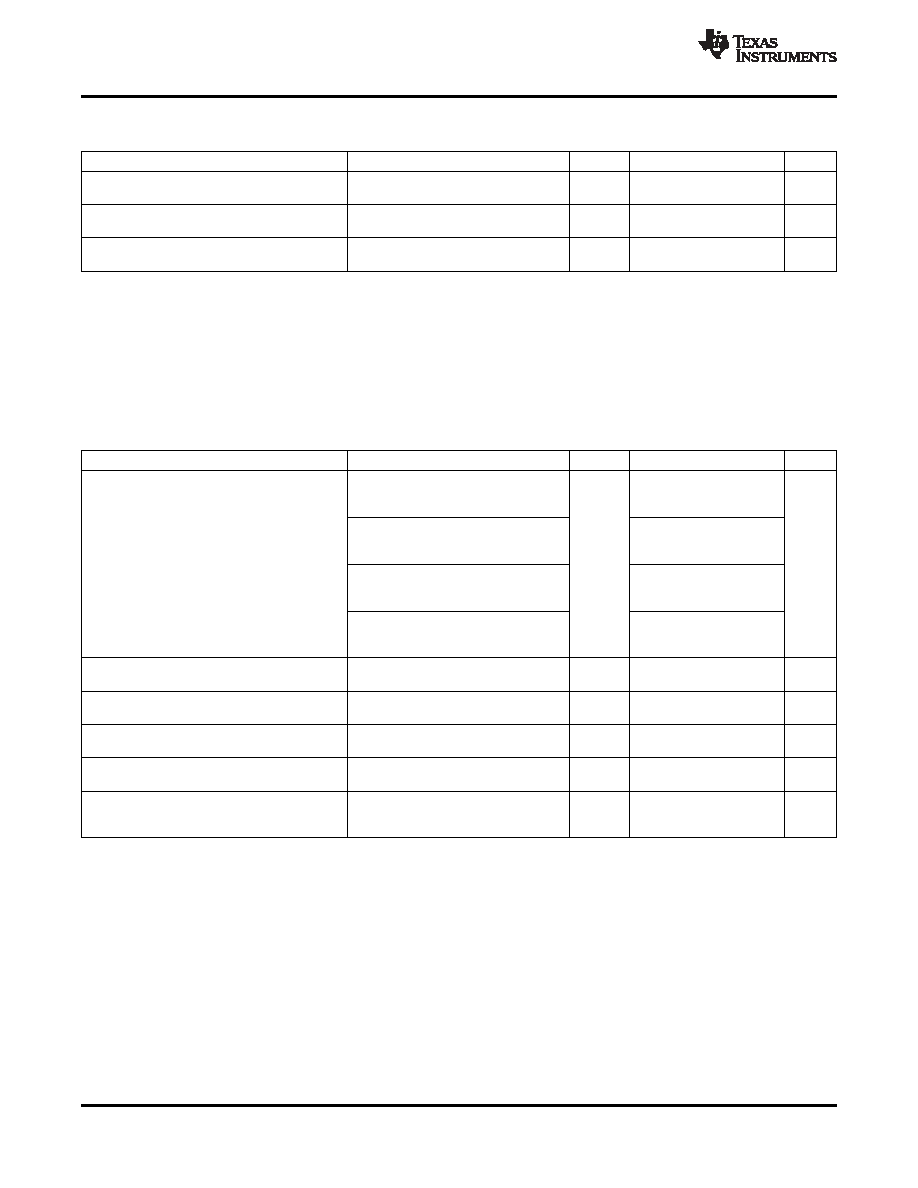- 您現在的位置:買賣IC網 > PDF目錄45398 > MSP430BT5190IZQW (TEXAS INSTRUMENTS INC) RISC MICROCONTROLLER, PBGA113 PDF資料下載
參數資料
| 型號: | MSP430BT5190IZQW |
| 廠商: | TEXAS INSTRUMENTS INC |
| 元件分類: | 微控制器/微處理器 |
| 英文描述: | RISC MICROCONTROLLER, PBGA113 |
| 封裝: | LEAD FREE, PLASTIC, BGA-113 |
| 文件頁數: | 43/97頁 |
| 文件大?。?/td> | 724K |
| 代理商: | MSP430BT5190IZQW |
第1頁第2頁第3頁第4頁第5頁第6頁第7頁第8頁第9頁第10頁第11頁第12頁第13頁第14頁第15頁第16頁第17頁第18頁第19頁第20頁第21頁第22頁第23頁第24頁第25頁第26頁第27頁第28頁第29頁第30頁第31頁第32頁第33頁第34頁第35頁第36頁第37頁第38頁第39頁第40頁第41頁第42頁當前第43頁第44頁第45頁第46頁第47頁第48頁第49頁第50頁第51頁第52頁第53頁第54頁第55頁第56頁第57頁第58頁第59頁第60頁第61頁第62頁第63頁第64頁第65頁第66頁第67頁第68頁第69頁第70頁第71頁第72頁第73頁第74頁第75頁第76頁第77頁第78頁第79頁第80頁第81頁第82頁第83頁第84頁第85頁第86頁第87頁第88頁第89頁第90頁第91頁第92頁第93頁第94頁第95頁第96頁第97頁

PRODUCTPREVIEW
MSP430BT5190
SLAS703 – APRIL 2010
www.ti.com
Crystal Oscillator, XT1, High-Frequency Mode
(continued)
over recommended ranges of supply voltage and operating free-air temperature (unless otherwise noted)
PARAMETER
TEST CONDITIONS
VCC
MIN
TYP
MAX
UNIT
Integrated effective load
CL,eff
XTS = 1
1
pF
capacitance, HF mode(5) (6)
XTS = 1, Measured at ACLK,
Duty cycle
HF mode
40
50
60
%
fXT1,HF2 = 20 MHz
Oscillator fault frequency,
fFault,HF
XTS = 1(8)
30
300
kHz
HF mode(7)
(5)
Includes parasitic bond and package capacitance (approximately 2 pF per pin).
Since the PCB adds additional capacitance, it is recommended to verify the correct load by measuring the ACLK frequency. For a
correct setup, the effective load capacitance should always match the specification of the used crystal.
(6)
Requires external capacitors at both terminals. Values are specified by crystal manufacturers.
(7)
Frequencies below the MIN specification set the fault flag. Frequencies above the MAX specification do not set the fault flag.
Frequencies in between might set the flag.
(8)
Measured with logic-level input frequency but also applies to operation with crystals.
Crystal Oscillator, XT2
over recommended ranges of supply voltage and operating free-air temperature (unless otherwise noted)
(1) (2)
PARAMETER
TEST CONDITIONS
VCC
MIN
TYP
MAX
UNIT
fOSC = 4 MHz, XT2OFF = 0,
XT2BYPASS = 0, XT2DRIVEx = 0,
200
TA = 25°C
fOSC = 12 MHz, XT2OFF = 0,
XT2BYPASS = 0, XT2DRIVEx = 1,
260
TA = 25°C
XT2 oscillator crystal current
IDVCC.XT2
3.0 V
A
consumption
fOSC = 20 MHz, XT2OFF = 0,
XT2BYPASS = 0, XT2DRIVEx = 2,
325
TA = 25°C
fOSC = 32 MHz, XT2OFF = 0,
XT2BYPASS = 0, XT2DRIVEx = 3,
450
TA = 25°C
XT2 oscillator crystal frequency,
fXT2,HF0
XT2DRIVEx = 0, XT2BYPASS = 0(3)
4
8
MHz
mode 0
XT2 oscillator crystal frequency,
fXT2,HF1
XT2DRIVEx = 1, XT2BYPASS = 0(3)
8
16
MHz
mode 1
XT2 oscillator crystal frequency,
fXT2,HF2
XT2DRIVEx = 2, XT2BYPASS = 0(3)
16
24
MHz
mode 2
XT2 oscillator crystal frequency,
fXT2,HF3
XT2DRIVEx = 3, XT2BYPASS = 0(3)
24
32
MHz
mode 3
XT2 oscillator logic-level
fXT2,HF,SW
square-wave input frequency,
XT2BYPASS = 1(4) (3)
1.5
32
MHz
bypass mode
(1)
Requires external capacitors at both terminals. Values are specified by crystal manufacturers.
(2)
To improve EMI on the XT2 oscillator the following guidelines should be observed.
(a) Keep the traces between the device and the crystal as short as possible.
(b) Design a good ground plane around the oscillator pins.
(c) Prevent crosstalk from other clock or data lines into oscillator pins XT2IN and XT2OUT.
(d) Avoid running PCB traces underneath or adjacent to the XT2IN and XT2OUT pins.
(e) Use assembly materials and praxis to avoid any parasitic load on the oscillator XT2IN and XT2OUT pins.
(f) If conformal coating is used, ensure that it does not induce capacitive/resistive leakage between the oscillator pins.
(3)
This represents the maximum frequency that can be input to the device externally. Maximum frequency achievable on the device
operation is based on the frequencies present on ACLK, MCLK, and SMCLK cannot be exceed for a given range of operation.
(4)
When XT2BYPASS is set, the XT2 circuit is automatically powered down. Input signal is a digital square wave with parametrics defined
in the Schmitt-trigger Inputs section of this datasheet.
48
Copyright 2010, Texas Instruments Incorporated
相關PDF資料 |
PDF描述 |
|---|---|
| MSP430C1101IDW | 16-BIT, FLASH, 8 MHz, RISC MICROCONTROLLER, PDSO20 |
| MSP430C1121IDW | 16-BIT, FLASH, 8 MHz, RISC MICROCONTROLLER, PDSO20 |
| MSP430C1121IPW | 16-BIT, FLASH, 8 MHz, RISC MICROCONTROLLER, PDSO20 |
| MSP430F1111AIRGE | 16-BIT, FLASH, 8 MHz, RISC MICROCONTROLLER, PQCC24 |
| MSP430C112IDW | 16-BIT, MROM, 5.35 MHz, RISC MICROCONTROLLER, PDSO20 |
相關代理商/技術參數 |
參數描述 |
|---|---|
| MSP430BT5190IZQWR | 功能描述:16位微控制器 - MCU MSP430BT5190 Mixed Sig MCU RoHS:否 制造商:Texas Instruments 核心:RISC 處理器系列:MSP430FR572x 數據總線寬度:16 bit 最大時鐘頻率:24 MHz 程序存儲器大小:8 KB 數據 RAM 大小:1 KB 片上 ADC:Yes 工作電源電壓:2 V to 3.6 V 工作溫度范圍:- 40 C to + 85 C 封裝 / 箱體:VQFN-40 安裝風格:SMD/SMT |
| MSP430BT5190IZQWT | 功能描述:16位微控制器 - MCU MSP430BT5190 Mixed Sig MCU RoHS:否 制造商:Texas Instruments 核心:RISC 處理器系列:MSP430FR572x 數據總線寬度:16 bit 最大時鐘頻率:24 MHz 程序存儲器大小:8 KB 數據 RAM 大小:1 KB 片上 ADC:Yes 工作電源電壓:2 V to 3.6 V 工作溫度范圍:- 40 C to + 85 C 封裝 / 箱體:VQFN-40 安裝風格:SMD/SMT |
| MSP430C091SPW | 制造商:TI 制造商全稱:Texas Instruments 功能描述:MIXED SIGNAL MICROCONTROLLER |
| MSP430C092SPW | 制造商:TI 制造商全稱:Texas Instruments 功能描述:MIXED SIGNAL MICROCONTROLLER |
| MSP430C09X | 制造商:TI 制造商全稱:Texas Instruments 功能描述:MIXED SIGNAL MICROCONTROLLER |
發(fā)布緊急采購,3分鐘左右您將得到回復。